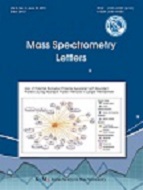
- P-ISSN 2233-4203
- E-ISSN 2093-8950

In the present study, we report that the charge-directed (assisted) peptide dissociation products, such as b- and y-type peptidebackbone fragments, were the major products in MS/MS and MS3 applications of some o-TEMPO-Bz-C(O)-peptide ions, whileradical-driven dissociation products, such as a/x and c/z-type fragments, were previously shown to be the major products in the freeradical initiated peptide sequencing mass spectrometry (FRIPS MS). Those o-TEMPO-Bz-C(O)-peptides share a common feature intheir sequences, that is, the peptides do not include an arginine residue that has the highest proton affinity among free amino acids. The appearance of b- and y-type fragments as major products in FRIPS MS can be understood in terms of the so-called “mobile-protonmodel”. When the proton is highly mobilized by the absence of arginine, the chare-directed peptide dissociation pathways appearto be more competitive than the radical-driven dissociation pathways, in our FRIPS experiments.
Zubarev, R. A. (1998). . J. Am. Chem. Soc, 120, 3265-.
Oh, H. B. (2002). . Proc. Natl. Acad. Sci. USA, 99, 15863-.
Zubarev, R. A. (2003). . Mass Spectrom. Rev, 22, 57-.
Leymarie, N. (2003). . J. Am. Chem. Soc, 125, 8949-.
Cooper, H. J. (2005). . Mass Spectrom. Rev, 24, 201-.
Fung, Y. M. E. (2005). . J. Am. Soc. Mass Spectrom, 16, 1523-.
HanBin Oh*. (2006). A Variety of Activation Methods Employed in “Activated-Ion” Electron Capture Dissociation Mass Spectrometry: A Test against Bovine Ubiquitin 7+ Ions. Bulletin of the Korean Chemical Society, 27(3), 389-394.
Lee, S. Y. (2006). . J. Am. Soc. Mass Spectrom, 17, 536-.
Yim, Y. H. (2006). . Rapid Commun Mass Spectrom, 20, 1918-.
Lee, S. Y. (2006). . Rapid Commun Mass Spectrom, 20, 3167-.
Chen, X. (2006). . J. Am. Chem. Soc, 128, 12520-.
Lee, S. Y. (2009). . Int. J. Mass Spectrom, 279, 47-.
Hamidane, H. B. (2009). . J. Am. Soc. Mass Spectrom, 20, 567-.
Kaczorowska, M. A. (2010). . J. Am. Soc. Mass Spectrom, 21, 300-.
Syka, J. E. (2004). . Proc. Natl. Acad. Sci. USA, 101, 9528-.
Chu, I. K. (2000). . J. Phys. Chem. B, 104, 3393-.
Barlow, C. K. (2005). . J. Am. Chem. Soc, 127, 6109-.
Chu, I. K. (2008). . J. Am. Chem. Soc, 130, 7862-.
Chu, I. K. (2011). . Eur. J. Mass Spectrom, 17, 543-.
Sun, Q. (2009). . J. Proteome Res, 8, -.
Masterson, D. S. (2004). . J. Am. Chem. Soc, 126, 720-.
Hodyss, R. (2005). . J. Am. Chem. Soc, 127, 12436-.
Lee, M. H. (2009). . Analyst, 134, 1706-.
Lee, M. H. (2011). . J. Mass Spectrom, 46, 830-.
Lee, J. H. (2013). . Anal. Chem, 85, 7044-.
Yalcin, T. (1995). . J. Am. Soc. Mass Spectrom, 6, 1165-.
Paizs, B. (2001). . Rapid Commun. Mass Spectrom, 15, 2307-.
Harrison, A. G. (1997). . Mass Spectrom. Rev, 16, 201-.
Laskin, J. (2007). . Anal. Chem, 79, 6607-.
Dongre, A. R. (1996). . J. Am. Chem. Soc, 118, 8365-.
Cordero, M. M. (1993). . Anal. Chem, 65, 1594-.